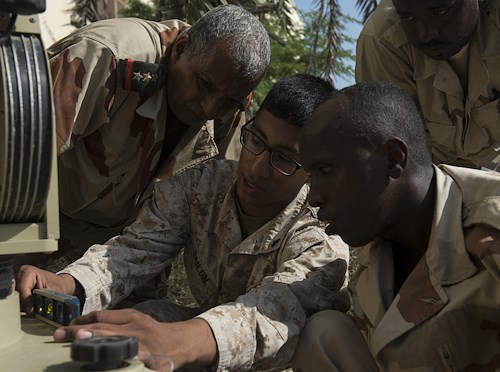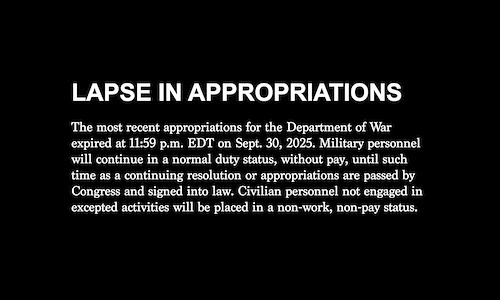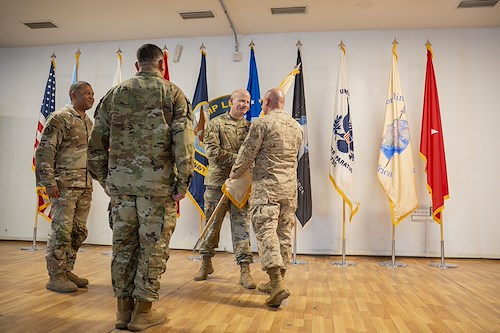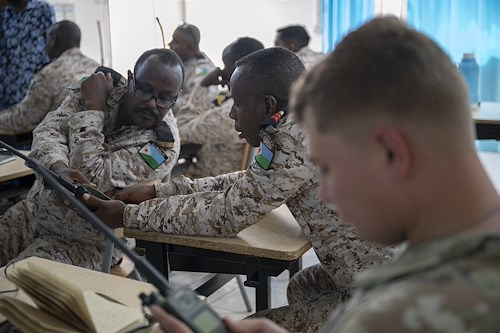Gallery contains 7 images
×
Photo 1 of 7
U.S., Djiboutian communications experts learn more about Africa Data Sharing Network
U.S. Marine Corps Cpl. Nehemias Bailon, Combined Joint Task Force-Horn of Africa, Africa Data Sharing Network (ADSN) help desk lead, demonstrates how to level the pedestal of an ADSN terminal Feb. 18, 2016, in Djibouti. The ADSN is a means for African Union Mission in Somalia (AMISOM) troop contributing countries to communicate and share information with the U.S. and amongst each other. Members of CJTF-HOA taught Djiboutian Armed Forces members how to install and operate a terminal, and how to access the ADSN. (U.S. Air Force photo by Senior Airman Peter Thompson)
Photo by: Senior Airman Peter Thompson
Photo 2 of 7
U.S., Djiboutian communications experts learn more about Africa Data Sharing Network
U.S. Marine Corps Cpl. Nehemias Bailon, Combined Joint Task Force-Horn of Africa, Africa Data Sharing Network (ADSN) help desk lead, explains a physical component of an ADSN terminal Feb. 18, 2016, in Djibouti. Members of the CJTF-HOA Communications Directorate met with Djiboutian Armed Forces ADSN soldiers and discussed how to configure and operate a terminal. (U.S. Air Force photo by Senior Airman Peter Thompson)
Photo by: Senior Airman Peter Thompson
Photo 3 of 7
U.S., Djiboutian communications experts learn more about Africa Data Sharing Network
U.S. Marine Corps Cpl. Nehemias Bailon, Combined Joint Task Force-Horn of Africa, Africa Data Sharing Network (ADSN) help desk lead (left), demonstrates how to use communication software Feb. 18, 2016, in Djibouti. Djiboutian Armed Forces (FAD) soldiers learned how to efficiently operate a terminal to access the ADSN. The FAD uses the ADSN to communicate with forward deployed soldiers. (U.S. Air Force photo by Senior Airman Peter Thompson)
Photo by: Senior Airman Peter Thompson
Photo 4 of 7
U.S., Djiboutian communications experts learn more about Africa Data Sharing Network
Members of Combined Joint Task Force-Horn of Africa Communications Directorate (CJ-6) and the Djiboutian Armed Forces (FAD) Africa Data Sharing Network (ADSN) section, set-up an ADSN terminal Feb. 18, 2016, in Djibouti. The engagement between the two forces was organized into two tiers, each consisting of two days. During the first tier, the three CJ-6 members covered the basics on how to operate the communication equipment. The second tier was more advanced and went more in depth on specific equipment roles, tracing signal flow and troubleshooting. (U.S. Air Force photo by Staff Sgt. Katherine Thornton)
Photo by: Staff Sgt. Katherine Thornton
Photo 5 of 7
U.S., Djiboutian communications experts learn more about Africa Data Sharing Network
U.S. Marine Corps Cpl. Nehemias Bailon, Combined Joint Task Force-Horn of Africa, Africa Data Sharing Network (ADSN) help desk lead, helps Djiboutian Armed Forces (FAD) Capt. Amer Abdarlaziz, ADSN section chief, configure an ADSN terminal Feb. 18, 2016, in Djibouti. The ADSN is a means for African Union Mission in Somalia (AMISOM) troop contributing countries to communicate and share information with the U.S. and amongst each other. Members of CJTF-HOA taught FAD members how to install and operate a terminal, and how to access the ADSN. (U.S. Air Force photo by Senior Airman Peter Thompson)
Photo by: Senior Airman Peter Thompson
Photo 6 of 7
U.S., Djiboutian communications experts learn more about Africa Data Sharing Network
U.S. Marine Corps Cpl. Nehemias Bailon, Combined Joint Task Force-Horn of Africa, Africa Data Sharing Network (ADSN) help desk lead (left), demonstrates how to use communication software Feb. 18, 2016, in Djibouti. Djiboutian Armed Forces (FAD) soldiers learned how to efficiently operate a terminal to access the ADSN. The FAD uses the ADSN to communicate with forward deployed soldiers. (U.S. Air Force photo by Senior Airman Peter Thompson)
Photo by: Senior Airman Peter Thompson
Photo 7 of 7
U.S., Djiboutian communications experts learn more about Africa Data Sharing Network
U.S. Marine Corps Cpl. Nehemias Bailon, Combined Joint Task Force-Horn of Africa, Africa Data Sharing Network (ADSN) help desk lead (left), demonstrates how to use communication software Feb. 18, 2016, in Djibouti. Djiboutian Armed Forces (FAD) soldiers learned how to efficiently operate a terminal to access the ADSN. The FAD uses the ADSN to communicate with forward deployed soldiers. (U.S. Air Force photo by Staff Sgt. Katherine Thornton)
Photo by: Staff Sgt. Katherine Thornton
Service members assigned to the Combined Joint Task Force-Horn of Africa Communications Directorate (CJ-6) visited the Djiboutian Armed Forces (FAD) Headquarters to share information on the Africa Data Sharing Network (ADSN) Feb. 15-18, in Djibouti.
The interaction between the CJ-6 personnel and more experienced soldiers of the FAD’s ADSN section reinforced and improved upon what they already knew about the network, while providing an opportunity to share differences in the way the U.S. military operates communication equipment.
“The ADSN is a means for troop contributing countries (in Somalia) to communicate and share information with the U.S. and amongst each other,” said U.S. Marine Corps Cpl. Nehemias Bailon, CJ-6 ADSN help desk lead. “Our training covered how to operate the equipment that gives them access to the ADSN.”
The engagement was divided into two tiers, each consisting of two days. During the first tier, three CJ-6 members covered the basics on how to operate the communication equipment. The second tier was more advanced, and went more in depth on specific equipment roles, tracing signal flow and troubleshooting.
As the event progressed, it became more evident that the FAD is making significant strides in reaching the goal of developing self-reliant communications operators.
“Before deploying their personnel, FAD trains soldiers on how to use the ADSN network with the terminal we were working on,” Bailon said. “Previously, they were less proficient in how to operate the equipment and systems. Because of the interaction we have had together, they can train their own personnel themselves.”
“The training is important because (ADSN) is a big service for us,” said FAD Capt. Amer Abdarlaziz, ADSN section chief. “It helps us when the Americans come and teach us things that are new, like some of this technology that we didn’t know.”
Abdarlaziz stressed that it is important for the FAD and CJTF-HOA continue to build upon the exchange of information because the ADSN network is critical for communicating with deployed soldiers.
In addition to aiding troop contributing countries such as Djibouti, CJTF-HOA members benefit through these sharing of best practice engagements.
“Every time I teach this system I learn something new,” Bailon said. “I have been working with this system for a while, but other people see things that I may not have. So this training helps us to grow as operators, as well.”

























